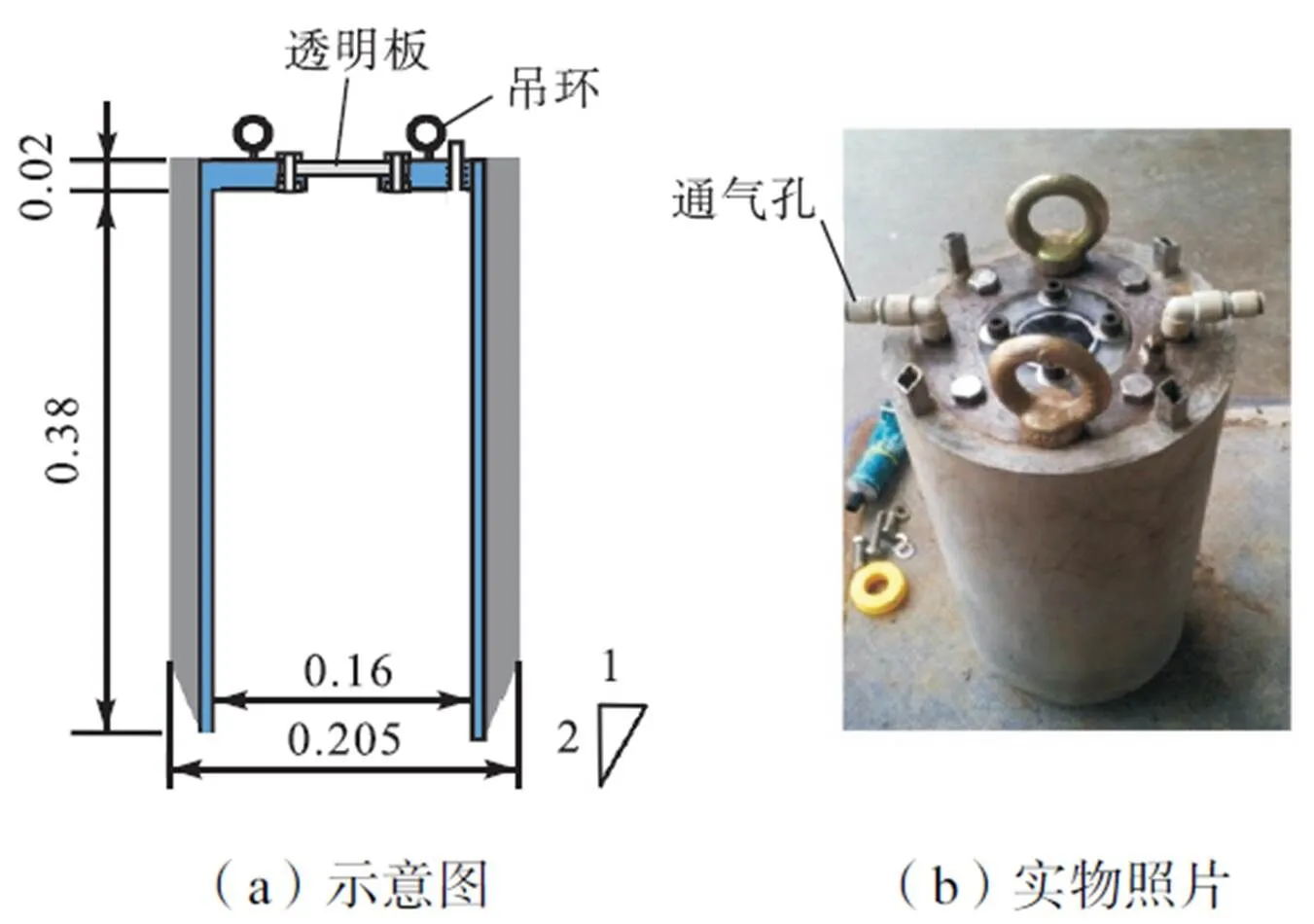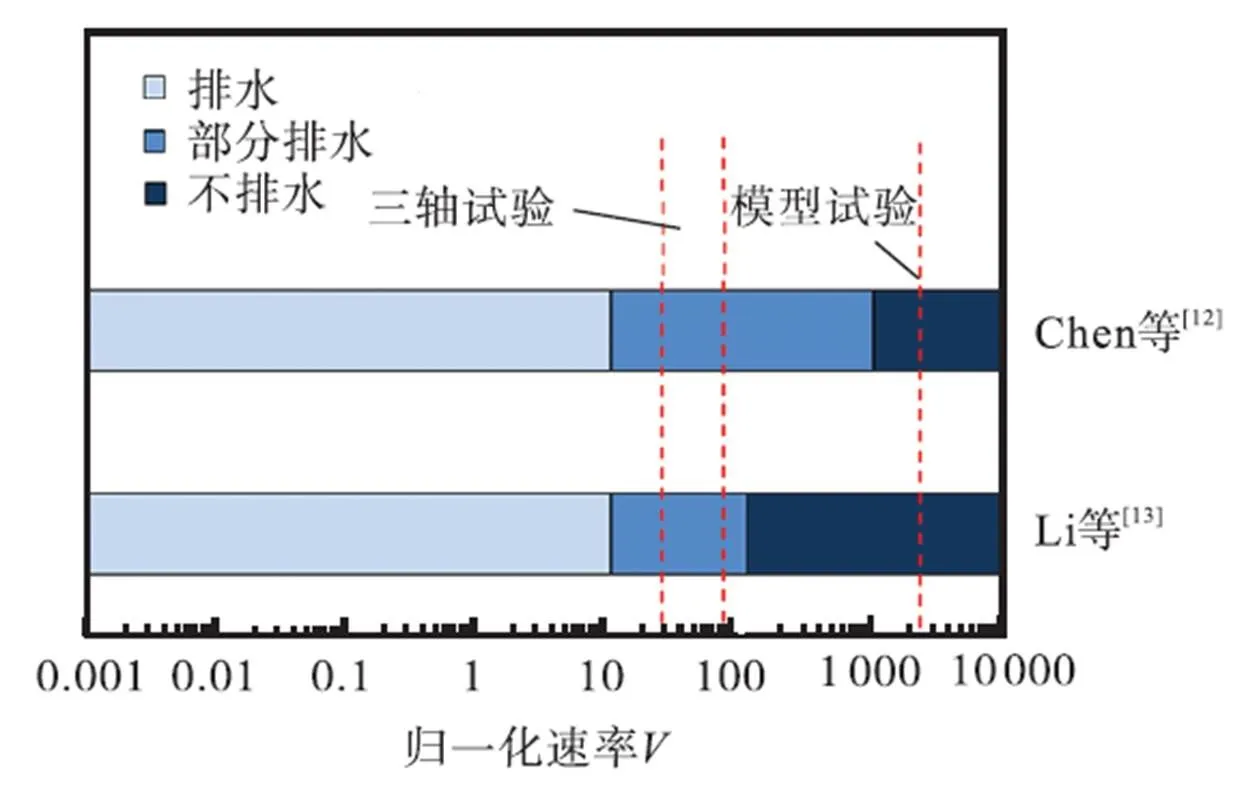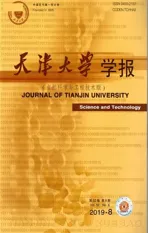关于修正剑桥模型预测负孔隙水应力的评析
2019-06-11张京京闫澍旺练继建郎瑞卿
张京京,闫澍旺,练继建,郎瑞卿
关于修正剑桥模型预测负孔隙水应力的评析
张京京1, 2,闫澍旺1,练继建1,郎瑞卿3
(1. 天津大学水利工程仿真与安全国家重点实验室,天津 300072;2. 中铁十八局集团有限公司,天津 300350;3. 天津城建大学土木工程学院,天津 300384)
在吸力锚和桩靴等海洋基础结构的上拔问题中,负孔隙水应力是抗拔阻力的重要组成部分,开展相关研究具有重要的科学意义和工程价值.修正剑桥模型不但可以合理地解释超静负孔隙水应力产生的机理,而且可以计算三轴卸荷过程中孔隙水应力的发展变化规律.通过开展高岭土地基桶形基础上拔室内模型试验,研究了总上拔力和超孔压随时间的变化情况;结合数值模拟,用修正剑桥模型计算卸荷对负孔隙水应力的影响,分析了上拔过程中负孔压分布特点;总结高岭土土体中受上拔速率影响的上拔承载力试验,并引入归一化速率对试验结果和数值计算结果进行分析,评析并量化了修正剑桥模型在预测负孔隙水应力时的适用条件.研究表明:负孔隙水压力在上拔初期主要集中在桶体下部和内部土体,对应的最大位移出现在桶裙底部;当上拔位移较大时,最大负孔压出现在桶内土体中;随着上拔位移的增大,土体中超静负孔压区域逐渐变大,同时桶形基础外侧土体发生向桶内的水平向位移.修正剑桥模型计算得到的超静负孔隙水应力小于模型试验结果,造成计算误差的主要原因为:剑桥修正计算模型是通过较低速率的三轴试验得到,其速率远远小于模型试验,从而低估了卸荷速率对负孔隙水应力的影响;修正剑桥模型预测负孔压的适用条件为归一化速率低于70.
修正剑桥模型;负孔隙水应力;适用条件;卸荷
吸附力是一种常见的作用于海洋工程结构物上的外部作用,其作用机理较复杂,是海洋岩土工程学科的重要组成部分.在风和浪等荷载的作用下,位于饱和黏土中的基础结构物处于上拔状态,对应的地基土进入卸荷状态,此时土体内产生负孔隙水压力,该力是吸附力的重要组成部分.负孔压在不同结构物和工程中有多种用途:在吸力锚、吸力桩等结构物中,负孔压可以用于抵抗外荷载;而在桩靴移动、打捞沉船等工程中,负孔压则是需要克服的不利因素. 因此,对负孔压的预测和计算具有重要的工程价值.
Li等[1]用有限元法结合修正剑桥模型阐述了负孔隙水应力的产生机理,文献[2-3]则通过三轴试验验证了负孔隙水应力产生机理的合理性.三轴试验、模型试验均表明,速率对负孔隙水应力有重要影响.为了探究修正剑桥模型预测孔隙水应力在模型试验中的应用效果,采用有限元法对桶型基础上拔试验进行模拟,根据分析结果论证该模型预测和计算孔隙水应力的适用性并量化相关适用条件.
1 MCC模型在桶形基础上拔试验中的应用
文献[4-11]开展了大量桶形基础上拔室内模型试验,并对上拔过程中的孔压分布进行了监测.结合以上模型试验和修正剑桥模型,探讨上拔过程中负孔压的预测和计算方法.
1.1 室内模型试验装置及试验用土
试验装置由固结试验槽、桶形基础模型和上拔设备等组成.其中,固结试验槽直径为1.0m,高度为1.4m,无缝不锈钢材质.具体模型试验装置见图1.
桶形基础模型(见图2)高度为0.40m,外径为0.205m,桶壁厚度为0.0225m,顶部厚度为0.02m.模型内部材料为钢材,外部为混凝土,总重为22.25kg.桶形基础内部净高为0.38m,基础裙底为楔形体,坡度为1∶2.为了便于监测土塞等现象,桶形基础顶部材料为透明的亚格力材料.

图1 模型试验装置

图2 桶形基础模型(单位:m)
高岭土使用广泛,但普遍具有固结系数小、渗透性低等特点.本次试验选用高岭土进行.试验用高岭土液限61,塑限38,相对体积质量2.61,灵敏度2.3.试验用土容重和含水率如图3所示.固结压力分别为25kPa和90kPa,固结压力用c表示.在预留的孔洞内采用十字板法测量高岭土的不排水强度u.高岭土的不排水强度u随深度不断变化,但是在固结桶内的变化非常有限,忽略不计,可认为地基土强度均匀.结合图3可知,25kPa固结压力下土体不排水强度u为5.7kPa,90kPa固结压力下桶内不排水强度u为16.7kPa.

图3 高岭土含水率及容量
1.2 有限元计算模型及参数选取
有限元计算模型(见图4)与试验尺寸相同,孔压测试点、埋深分别为20cm、40cm,如图4所示.上拔时固结应力不卸除,计算模型应力状态与试验相同.计算参数见表1.

图4 有限元计算模型
表1 计算参数

Tab.1 Calculation parameters
通过观察试验过程可知,试验上拔过程中桶内土体与桶体脱离,发生剪切破坏[11].因此,在数值模拟中,可将桶壁与土体之间的接触设置为可脱离摩擦.根据模型试验反算,侧壁摩擦系数为0.11.
1.3 有限元计算结果分析
上拔承载力试验结果与数值模拟结果对比如图5所示.对比图5中两条曲线可以看出,数值模拟得到的上拔力与试验测得的上拔力较为吻合.

图5 上拔力计算结果
通过数值模拟可较为详细地研究上拔过程中孔压的分布.不同上拔位移对应的土体孔压分布见图6.
由图6可以看出:当上拔位移较小时,负孔隙水压力主要集中在桶体下部和内部土体,对应的最大位移出现在桶裙底部;当向上位移较大时,最大负孔压出现在桶内土体中;随着桶形基础被不断拔出,土体中超静负孔压区域逐渐变大,同时桶形基础外侧土体发生向桶内的水平向位移.该现象表明,在上拔过程中,桶壁作用于周围土体上的作用不仅有剪切作用,还有水平向卸荷作用,从而导致了负孔压的产生[1-2].
对上拔过程中,深度为0.20m和0.40m处的土体孔压变化进行监测.数值计算所得孔压与试验值对比如图7所示.

图7 数值模拟孔压值与实测结果对比
由图7可知,试验测得的孔压与计算值存在一定差异:深度为0.2m处,最大负孔压实测值为-6kPa,而数值模拟值为-1.5kPa;深度为0.4m处,最大负孔压实测值为-10kPa,而数值模拟值为-3.2kPa.由此可见,采用MCC模型计算得到的孔压小于模型试验的实测值.
2 高岭土卸荷速率效应影响分析
Chen等[12]和Li等[13]的研究表明,卸荷速率对负孔隙水应力有重要影响,卸荷速率越快负孔隙水应力越大,对卸荷速率、埋深或排水路径和固结系数v进行归一化处理,得到归一化速率=/v,并通过分析得到完全不排水、部分排水、完全排水条件的速率界限,如图8所示.

图8 高岭土中模型试验速率归一化
由图8可知,根据Chen等[12]的研究结果可将归一化速率为10~1000的试验界定为卸荷时部分排水问题;而若根据Li等[13]的研究结果该速率介于10~100之间.
本文中桶形基础模型试验拔出速率为3.23cm/min,孔压测试点、有效排水路径分别为0.20m和0.40m,试验用高岭土的固结系数v为1.5m2/a,则计算得到两点归一化速率分别为1582、3164.修正剑桥模型根据三轴试验结果建立,为了确定有限元计算模型速率效应的影响作用,对高岭土三轴试验速率进行归一化分析.三轴试样尺寸为14cm×7cm,试验速率0.05%~0.10%/min,高岭土三轴试验归一化速率为17.0~68.6.结合图8中相关界定数值可知,试验用土常规三轴试验可界定为部分排水状态,而本文中上拔模型试验则属于不排水 问题.
速率对负孔压值有很大的影响,Chen等[12]和Li等[13]的研究表明,卸荷速率越快则负孔隙水应力越大,三轴试验也验证了这一结论[12].MCC模型是在归一化速率较低三轴试验条件下得到的本构关系,而本文模型试验的归一化速率较高.因此,运用MCC模型计算得到本文试验条件下的孔压结果偏小.
当通过较低速率三轴试验得到的本构模型预测并计算土体中负孔压的发展及相应的应力状态时,可能会造成计算结果偏小,低估了负孔压的作用.当三轴试验的加载速率与实际情况相同时,即图8中的完全不排水条件时,运用固结理论考虑速率的影响才能得到与实际工程较为接近的结果.因此,通过常规三轴试验得到的修正剑桥模型较为适用于低速率(对于高岭土为归一化速率小于70)的卸荷问题,而对于归一化速率较大的卸荷问题尚需另做研究.当卸荷速率较快时,模型试验更适用于负孔压预测.
3 结 论
采用有限元法研究修正剑桥模型在桶形基础上拔问题中的应用,主要得出以下结论.
(1) 采用修正剑桥模型对高岭土地基中桶形基础上拔试验进行分析,数值计算得到的负孔压小于实测值.该现象产生的原因为:修正剑桥模型在较低速率的常规三轴试验中得到,该速率远低于模型试验条件,而卸荷速率越快,负孔隙水应力越大,修正剑桥模型低估了速率对孔压的影响.
(2) 修正剑桥模型能够揭示负孔隙水应力的产生机理,但较适用于计算低速卸荷条件下孔压值.对于高岭土,该低速卸荷条件的界限值为70,而对于较高速率的卸荷问题则参考模型试验结果进行预测更为合理.
[1] Li X J,Tian Y H,Gaudin C,et al. Comparative study of the compression and uplift of shallow foundations[J]. Computers and Geotechnics,2015,69(5):38-45.
[2] Yan S W,Zhang J J,Tian Y H,et al. Pore pressure characteristics in isotropic consolidated saturated clay under unloading conditions[J]. Journal of Marine Science and Technology,2016,24(1):19-25.
[3] 闫澍旺,张京京,陶 琳,等. 等向固结饱和黏土卸荷特性影响因素研究[J]. 岩土工程学报,2016,38(增2):42-47.
Yan Shuwang,Zhang Jingjing,Tao Lin,et al. Influencing factors for unloading characteristics in saturated clay[J]. Chinese Journal of Geotechnical Engineering,2016,38(Suppl 2):42-47(in Chinese).
[4] 闫澍旺,霍知亮,楚 剑,等. 黏土中负压桶形基础下沉与承载特性试验及有限元分析研究[J]. 工程力学,2016,33(1):122-132.
Yan Shuwang,Huo Zhiliang,Chu Jian,et al. Test and FEA of installation and axial behavior of suction caisson in clay[J]. Engineering Mechanic,2016,33(1):122-132(in Chinese).
[5] 闫澍旺,霍知亮,孙立强,等. 海上风电机组筒型基础工作及承载特性研究[J]. 岩土力学,2013,34(7):2036-2042.
Yan Shuwang,Huo Zhiliang,Sun Liqiang,et al. Study of working mechanism and bearing capacity behavior of bucket foundation for offshore wind turbine [J]. Rock and Soil Mechanics,2013,34(7):2036-2042(in Chinese).
[6] Chu J,Yan S W,Li W. Innovative methods for dike construction—An overview[J]. Geotextiles and Geomembranes,2012,30(2):35-42.
[7] He J,Chu J,Liu H L. Undrained shear strength of desaturated loose sand under monotonic shearing[J]. Soils & Foundations,2014,54(4):910-916.
[8] Guo W,Chu J,Kou H. Model tests of soil heave plug formation in suction caisson[J]. Proceedings of the Institution of Civil Engineers-Geotechnical Engineering,2016,169(2):214-223.
[9] Guo W,Chu J. Experimental study of installation of concrete suction caisson in clay[C]//Proceedings of the Institution of Civil Engineers. San Antonio Texas,USA,2015:784-791.
[10] Guo Z,Wang L,Yuan F,et al. Model tests on installation techniques of suction caissons in a soft clay seabed[J]. Applied Ocean Research,2012,34(1):116-125.
[11] 霍知亮. 黏土地基中桶形基础模型试验及工作机理研究[D]. 天津:天津大学建筑工程学院,2015.
Huo Zhiliang. Model Test and Working Mechanism Study of Suction Caisson in Clay[D]. Tianjin:School of Civil Engineering,Tianjin University,2015(in Chinese).
[12] Chen R,Gaudin C,Cassidy M J. Investigation of the vertical uplift capacity of deep water mudmats in clay[J]. Canadian Geotechnical Journal,2012,49(7):853-865.
[13] Li X,Gaudin C,Tian Y,et al. Rate effects on the uplift capacity of skirted foundations on clay[C]// ICPMG 2014-Physical Modelling in Geotechnics. London,UK,2014:473-479.
Analysis on Predicting Negative Pore Stress Using Modified Cambridge Model
Zhang Jingjing1, 2,Yan Shuwang1,Lian Jijian1,Lang Ruiqing3
(1. State Key Laboratory of Hydraulic Engineering Simulation and Safety,Tianjin University,Tianjin 300072,China;2. China Railway 18 Bureau Group Co.,LTD,Tianjin 300350,China;3. School of Civil Engineering,Tianjin Chengjian University,Tianjin 300384,China)
The negative pore pressure is an important component of the pullout force in the uplifting project of offshore engineering structures,such as a caisson or a jackup spudcan. It has great scientific significance and engineering value to carry out relevant research. The modified Cambridge model not only can explain the mechanism of negative pore water stress reasonably but also can calculate the development of pore water stress during the triaxial unloading process. Based on the pull model tests of bucket foundation in kaolin soil,variations of the total pullout force and excess pore pressure with time were studied. Combined with the numerical simulation,the modified Cambridge model was used to calculate the influence of unloading on the negative pore water stress. Moreover,the distribution of negative pore pressure during the uplifting process was analyzed. The uplift capacities of kaolin soil affected by the uplift rate were summarized,and the normalization rate was proposed to analyze the test and numerical calculation results. Furthermore,the applicable conditions of the modified Cambridge model was evaluated and quantified. The research showed that the negative pore water pressure mainly appeared at the lower part and the internal soil during the initial stage of uplifting,whereas the corresponding maximum displacement occurred at the bottom of the bucket skirt. When the upward displacement was large,the maximum negative pore pressure was observed in the soil inside the bucket. The area of the negative pore pressure increased gradually with increasing uplift displacement. The soil outside the bucket produced horizontal displacement into the bucket. The calculated value of the negative pore pressure using the modified Cambridge model is less than the test value. The modified Cambridge model was obtained from triaxial test with a low rate,much smaller than that of the model tests. Therefore,the influence of unloading rate on the negative pore water stress was underestimated. The applicable condition for calculating the negative pore pressure of the modified Cambridge model is a normalized rate of less than 70.
modified Cambridge model;negative pore stress;applicable condition;unloading
TU758.11
A
0493-2137(2019)08-0871-05
10.11784/tdxbz201806032
2018-06-15;
2018-11-05.
张京京(1989— ),女,博士,工程师,zhangjj0305@163.com.
郎瑞卿,tculrq@163.com.
国家自然科学基金资助项目(41372291);天津市科技计划资助项目(15ZCZDF00220);天津市应用基础与前沿技术研究计划资助项目(15JCYBJC48800).
the National Natural Science Foundation of China(No.41372291),the Tianjin Science and Technology Project (No.15ZCZDF00220),the Tianjin Key Research Program of Application Foundation and Advanced Technology (No.15JCYBJC48800).
(责任编辑:樊素英)
